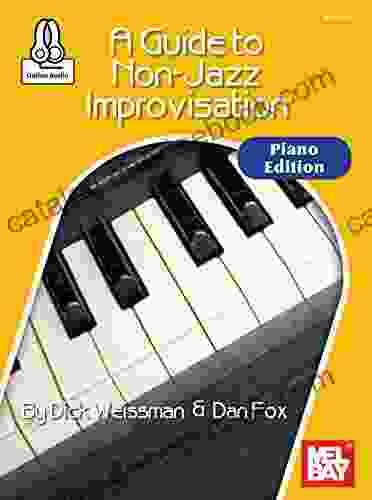A Comprehensive Guide to Non-Jazz Improvisation for Piano: Techniques, Exercises, and Tips

: Embracing the Art of Improvisation
Improvisation, the art of creating music spontaneously, is an exhilarating and rewarding pursuit that transcends the boundaries of musical genres. While jazz improvisation holds a prominent place in the musical landscape, non-jazz improvisation offers a unique and accessible path for pianists to explore their creativity and connect with their inner musicality.
5 out of 5
| Language | : | English |
| File size | : | 23182 KB |
| Print length | : | 134 pages |
| Screen Reader | : | Supported |
This comprehensive guide will delve into the realm of non-jazz improvisation for piano, providing a thorough exploration of techniques, exercises, and practical tips to help you embark on this exciting musical journey. Whether you're a seasoned pianist seeking to expand your horizons or a beginner渴望释放你的创造力,这份指南将成为你通往即兴创作世界的重要伙伴。
Chapter 1: Understanding Non-Jazz Improvisation
1.
The Essence of Non-Jazz Improvisation
Non-jazz improvisation encompasses a vast array of styles and approaches, encompassing classical, romantic, contemporary, and experimental music. Unlike jazz improvisation, which typically adheres to specific harmonic frameworks and rhythmic patterns, non-jazz improvisation grants pianists greater freedom to explore diverse musical languages and express their unique artistic visions.
1.
Benefits of Non-Jazz Improvisation
Embracing non-jazz improvisation can profoundly enhance your musicality and overall piano playing skills. It fosters creativity, improves ear training, develops technical dexterity, and strengthens your connection with the instrument. Additionally, improvisation can boost your confidence and provide a therapeutic outlet for self-expression.
Chapter 2: Essential Techniques and Skills
1.
Building a Solid Foundation
Before embarking on improvisation, it's crucial to establish a strong foundation in music theory and fundamental piano techniques. This includes understanding scales, chords, arpeggios, and basic rhythmic patterns. A solid foundation will provide you with the necessary building blocks to construct your improvisational solos.
1.
Exploring Scales and Arpeggios
Scales and arpeggios serve as the backbone of improvisation. Practice playing scales in various keys and tempos to improve your finger dexterity and melodic fluency. Similarly, arpeggios provide a rich source of harmonic and melodic material for improvisation.
1.
Mastering Chord Progressions
Chord progressions form the harmonic framework for improvisation. Familiarize yourself with common progressions and practice transitioning smoothly between chords. Experiment with different voicings and inversions to create varied and interesting textures.
1.
Developing Rhythmic Vocabulary
Rhythm plays a vital role in improvisation. Practice playing a variety of rhythmic patterns, including syncopated rhythms, triplets, and swing rhythms. Combine rhythmic patterns with scales and arpeggios to create engaging melodic lines.
1.
Active Listening and Ear Training
Active listening and ear training are essential for effective improvisation. Listen attentively to your own playing and identify areas for improvement. Transcribe melodies, chords, and rhythms from recordings to enhance your musical vocabulary and develop your ability to recognize and reproduce musical patterns.
Chapter 3: Exercises for Improvisation
1.
Free Improvisation Practice
Set aside dedicated time for free improvisation, where you can freely explore the piano without any preconceived notions or limitations. Experiment with different sounds, rhythms, and harmonic progressions to discover your unique musical voice.
1.
Motif Development
Create short musical motifs and use them as the foundation for improvisation. Develop variations and embellishments on these motifs to create extended improvisational solos.
1.
Chord Progression Practice
Practice improvising over chord progressions. Start with simple progressions and gradually increase the complexity as your skills develop. Focus on creating melodic lines that complement the underlying harmonic structure.
1.
Scale and Arpeggio Improvisation
Use scales and arpeggios as the basis for improvisation. Experiment with different scale patterns, arpeggio voicings, and rhythmic variations to create diverse melodic ideas.
1.
Structured Improvisation
Incorporate structure into your improvisation by setting boundaries or challenges. For example, limit yourself to using a specific set of notes or scales, or improvise within a particular time frame. Structured improvisation can help you develop focus and discipline.
Chapter 4: Tips for Enhancing Your Improvisation
1.
Embrace Mistakes
Improvisation involves taking risks and experimenting; mistakes are an inherent part of the process. Embrace mistakes as opportunities for learning and growth.
1.
Stay Relaxed and Focused
保持放松,专注于音乐。避免过度思考或批评自己。让你的直觉带领你,自由地表达你的音乐想法。
1.
Listen to Diverse Music
Expose yourself to various musical genres and styles. Listening to different types of music will broaden your musical horizons and provide inspiration for your improvisation.
1.
Record and Analyze
Record your improvisational sessions to identify areas for improvement. Listen back to your recordings and analyze your strengths and weaknesses. This will help you pinpoint problem areas and develop strategies for improvement.
1.
Seek Feedback and Collaboration
Share your improvisational work with friends, fellow musicians, or a piano teacher. Seek feedback and engage in constructive discussions about your playing. Collaboration with other musicians can also provide valuable insights and push you to grow as an improviser.
: Unleashing Your Creative Potential
Embracing non-jazz improvisation for piano is a transformative journey that empowers you to express your unique musicality and captivate audiences with spontaneous and inspired performances. Through the techniques, exercises, and tips outlined in this guide, you can unlock your improvisational potential and experience the joy and freedom of creating music in the moment.
Remember, improvisation is a continuous process of learning, exploration, and self-discovery. Embrace the challenges, celebrate the successes, and never stop exploring the boundless possibilities of non-jazz improvisation for piano.
Let your creativity soar and let the music flow through you, one spontaneous note at a time.
5 out of 5
| Language | : | English |
| File size | : | 23182 KB |
| Print length | : | 134 pages |
| Screen Reader | : | Supported |
Do you want to contribute by writing guest posts on this blog?
Please contact us and send us a resume of previous articles that you have written.
 Chapter
Chapter Text
Text Genre
Genre Reader
Reader Paperback
Paperback E-book
E-book Magazine
Magazine Newspaper
Newspaper Sentence
Sentence Shelf
Shelf Glossary
Glossary Bibliography
Bibliography Foreword
Foreword Preface
Preface Footnote
Footnote Manuscript
Manuscript Scroll
Scroll Bestseller
Bestseller Library card
Library card Narrative
Narrative Autobiography
Autobiography Reference
Reference Dictionary
Dictionary Thesaurus
Thesaurus Librarian
Librarian Card Catalog
Card Catalog Borrowing
Borrowing Archives
Archives Periodicals
Periodicals Lending
Lending Academic
Academic Journals
Journals Special Collections
Special Collections Interlibrary
Interlibrary Study Group
Study Group Dissertation
Dissertation Awards
Awards Reading List
Reading List Book Club
Book Club Theory
Theory Casey B Mulligan
Casey B Mulligan Barbara Wheat
Barbara Wheat Nicholas Humphrey
Nicholas Humphrey Joy Barrett
Joy Barrett Dawson Nichols
Dawson Nichols Stephanie Marohn
Stephanie Marohn Ariel Setobarko
Ariel Setobarko Lea Rawls
Lea Rawls Daisy Goodwin
Daisy Goodwin Duane Hamacher
Duane Hamacher Kelly M Greenhill
Kelly M Greenhill Mohan Sarma
Mohan Sarma Brendan Deneen
Brendan Deneen Brad Benefield
Brad Benefield Ashley Antoinette
Ashley Antoinette Alex Anderson
Alex Anderson Leon Rubin
Leon Rubin Kyle Gann
Kyle Gann Judy
Judy Braja Sorensen
Braja Sorensen
Light bulbAdvertise smarter! Our strategic ad space ensures maximum exposure. Reserve your spot today!

 Gregory WoodsBarcelona: A Journey Through Time - A Photographic Exploration of the City's...
Gregory WoodsBarcelona: A Journey Through Time - A Photographic Exploration of the City's... Seth HayesFollow ·5.1k
Seth HayesFollow ·5.1k Reed MitchellFollow ·16.1k
Reed MitchellFollow ·16.1k Ibrahim BlairFollow ·6k
Ibrahim BlairFollow ·6k Sidney CoxFollow ·2.6k
Sidney CoxFollow ·2.6k Jamal BlairFollow ·5.6k
Jamal BlairFollow ·5.6k Mario SimmonsFollow ·5.5k
Mario SimmonsFollow ·5.5k Darren NelsonFollow ·16.7k
Darren NelsonFollow ·16.7k Preston SimmonsFollow ·17.1k
Preston SimmonsFollow ·17.1k

 Hayden Mitchell
Hayden MitchellThe Routledge Handbook of Feminist Peace Research: A...
The Routledge...

 Joe Simmons
Joe SimmonsUnveiling the Lyrical Mastery of Henri Cole's "Blizzard...
In the realm of...

 E.E. Cummings
E.E. CummingsEast End Hardman To Tv Star: The Unlikely Rise Of Danny...
Danny Dyer is one of the...

 Eli Brooks
Eli BrooksMusic in the Tradition of Thich Nhat Hanh: A Journey of...
In the heart of...

 Samuel Ward
Samuel WardAmazing Scenes in Plastic Canvas: Bringing Your...
Plastic canvas is a...

 E.E. Cummings
E.E. CummingsA Comprehensive Guide to Non-Jazz Improvisation for...
: Embracing the Art of...
5 out of 5
| Language | : | English |
| File size | : | 23182 KB |
| Print length | : | 134 pages |
| Screen Reader | : | Supported |









